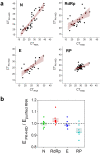Extraction-free protocol combining proteinase K and heat inactivation for detection of SARS-CoV-2 by RT-qPCR
- PMID: 33635936
- PMCID: PMC7909620
- DOI: 10.1371/journal.pone.0247792
Extraction-free protocol combining proteinase K and heat inactivation for detection of SARS-CoV-2 by RT-qPCR
Abstract
Real-time reverse transcription PCR (RT-qPCR) is the gold-standard technique for severe acute respiratory syndrome coronavirus 2 (SARS-CoV-2) detection in nasopharyngeal swabs specimens. The analysis by RT-qPCR usually requires a previous extraction step to obtain the purified viral RNA. Unfortunately, RNA extraction constitutes a bottleneck for early detection in many countries since it is expensive, time-consuming and depends on the availability of commercial kits. Here, we describe an extraction-free protocol for SARS-CoV-2 detection by RT-qPCR from nasopharyngeal swab clinical samples in saline solution. The method includes a treatment with proteinase K followed by heat inactivation (PK+HID method). We demonstrate that PK+HID improves the RT-qPCR performance in comparison to the heat-inactivation procedure. Moreover, we show that this extraction-free protocol can be combined with a variety of multiplexing RT-qPCR kits. The method combined with a multiplexing detection kit targeting N and ORF1ab viral genes showed a sensitivity of 0.99 and a specificity of 0.99 from the analysis of 106 positive and 106 negative clinical samples. In conclusion, PK+HID is a robust, fast and inexpensive procedure for extraction-free RT-qPCR determinations of SARS-CoV-2. The National Administration of Drugs, Foods and Medical Devices of Argentina has recently authorized the use of this method.
Conflict of interest statement
VG, MStortz, AW, BGB, PV, VD, FRL and VL participate in a Transfer Agreement between Facultad de Ciencias Exactas y Naturales (University of Buenos Aires), National Research Council –CONICET and Inbio Highway (Tandil, Argentina). This agreement was not signed yet at the moment of submission. MSalvatori declares no competing interest.
Figures




Similar articles
-
Highly sensitive extraction-free saliva-based molecular assay for rapid diagnosis of SARS-CoV-2.J Clin Microbiol. 2024 Jun 12;62(6):e0060024. doi: 10.1128/jcm.00600-24. Epub 2024 May 24. J Clin Microbiol. 2024. PMID: 38785448 Free PMC article.
-
Comparative effects of viral-transport-medium heat inactivation upon downstream SARS-CoV-2 detection in patient samples.J Med Microbiol. 2021 Mar;70(3):001301. doi: 10.1099/jmm.0.001301. Epub 2021 Mar 18. J Med Microbiol. 2021. PMID: 33734960 Free PMC article.
-
Comparative evaluation of six nucleic acid amplification kits for SARS-CoV-2 RNA detection.Ann Clin Microbiol Antimicrob. 2021 May 22;20(1):38. doi: 10.1186/s12941-021-00443-w. Ann Clin Microbiol Antimicrob. 2021. PMID: 34022903 Free PMC article.
-
Rapid and Extraction-Free Detection of SARS-CoV-2 from Saliva by Colorimetric Reverse-Transcription Loop-Mediated Isothermal Amplification.Clin Chem. 2021 Jan 30;67(2):415-424. doi: 10.1093/clinchem/hvaa267. Clin Chem. 2021. PMID: 33098427 Free PMC article.
-
A simple, safe and sensitive method for SARS-CoV-2 inactivation and RNA extraction for RT-qPCR.APMIS. 2021 Jul;129(7):393-400. doi: 10.1111/apm.13123. Epub 2021 Mar 17. APMIS. 2021. PMID: 33730407 Free PMC article.
Cited by
-
Different Respiratory Samples for COVID-19 Detection by Standard and Direct Quantitative RT-PCR: A Literature Review.Iran J Pharm Res. 2021 Summer;20(3):285-299. doi: 10.22037/ijpr.2021.115458.15383. Iran J Pharm Res. 2021. PMID: 34903989 Free PMC article. Review.
-
Resilient SARS-CoV-2 diagnostics workflows including viral heat inactivation.medRxiv [Preprint]. 2021 Apr 10:2020.04.22.20074351. doi: 10.1101/2020.04.22.20074351. medRxiv. 2021. Update in: PLoS One. 2021 Sep 15;16(9):e0256813. doi: 10.1371/journal.pone.0256813. PMID: 33851184 Free PMC article. Updated. Preprint.
-
A novel viral RNA detection method based on the combined use of trans-acting ribozymes and HCR-FRET analyses.PLoS One. 2024 Sep 26;19(9):e0310171. doi: 10.1371/journal.pone.0310171. eCollection 2024. PLoS One. 2024. PMID: 39325749 Free PMC article.
-
Dry Swab-Based Nucleic Acid Extraction vs. Spin Column-Based Nucleic Acid Extraction for COVID-19 RT-PCR Testing: A Comparative Study.Can J Infect Dis Med Microbiol. 2023 Aug 23;2023:6624932. doi: 10.1155/2023/6624932. eCollection 2023. Can J Infect Dis Med Microbiol. 2023. PMID: 37663452 Free PMC article.
-
Direct Lysis RT-qPCR of SARS-CoV-2 in Cell Culture Supernatant Allows for Fast and Accurate Quantification.Viruses. 2022 Feb 28;14(3):508. doi: 10.3390/v14030508. Viruses. 2022. PMID: 35336915 Free PMC article.
References
-
- Kucharski AJ, Klepac P, Conlan AJK, Kissler SM, Tang ML, Fry H, et al.. Effectiveness of isolation, testing, contact tracing, and physical distancing on reducing transmission of SARS-CoV-2 in different settings: a mathematical modelling study. Lancet Infect Dis. 2020. Epub 2020/06/20. 10.1016/S1473-3099(20)30457-6 . - DOI - PMC - PubMed
-
- Akst J. RNA Extraction Kits for COVID-19 Tests Are in Short Supply in US. The Scientist Magazine. 2020 Mar 11, 2020.
-
- Slabodkin G. FDA chief warns of supply ’pressure’ on reagents for coronavirus tests. MedTech Dive Magazine. 2020 March 12, 2020.
Publication types
MeSH terms
Substances
Supplementary concepts
LinkOut - more resources
Full Text Sources
Other Literature Sources
Medical
Miscellaneous

